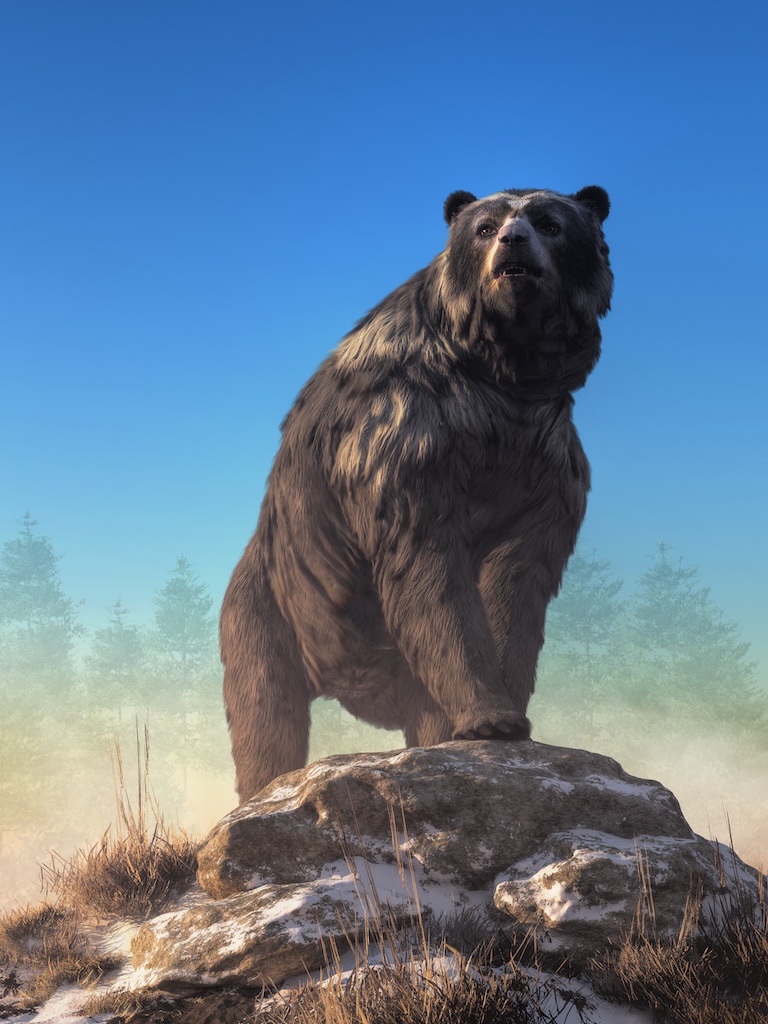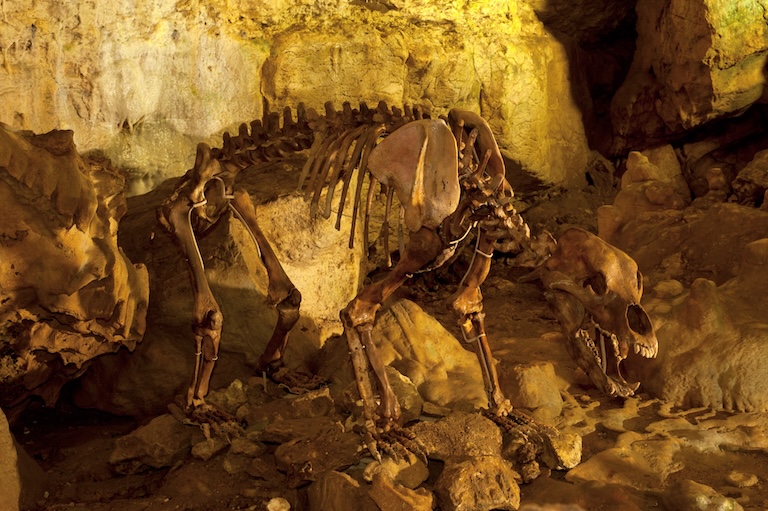Cave Bear Profile
The Pleistocene was riddled with enormous carnivores, evolved to take down the colossal herbivores that dominated the landscape, but not all of these were as they seemed.
In the caves of Western Europe, early humans once competed for space with an enormous bear. This surprising animal was the size of a polar bear, but may instead have been a gentle giant.

Cave Bear Facts Overview
| Habitat: | Wooded regions, wintering in limestone caves |
| Location: | Europe |
| Lifespan: | Possibly less than 20 years |
| Size: | Around 2 meters (6’6”) long |
| Weight: | Possibly Up to 1000kg |
| Colour: | Unknown |
| Diet: | Vegetation, occasional scavengers of meat |
| Predators: | Wolves, cave hyenas, humans |
| Top Speed: | Unknown |
| No. of Species: | 1 |
| Conservation Status: | Extinct |
Cave bears would have matched some of the largest extant bear species in size, but had a far less predatory lifestyle. Their heads were more evolved for sleeping than killing, and this may have been what led to their extinction.
Their remains litter caves all over Europe and their skulls have been found alongside Neanderthal remains, sparking debate over their role in ancient hominin culture.
Interesting Cave Bear Facts
1. They diverged from the brown bear lineage
Around a million years ago, ice ages began getting longer and more intense. At this point in history, three branches of the cave bear began to diverge. This was about the same time that polar bears and brown bears branched off too.
From one of the brown bear lineages evolved a stout and powerful animal that would become one of the most prevalent mammals of the Pleistocene. There were so many of these guys that their bones litter caves across their ancient habitats, and were often discarded by researchers for being too plentiful.
Not only were they everywhere, but they were also huge. 1

2. They were larger than a Grizzly bear
Though cave bears shared a space with the Grizzly, they were significantly larger animals. Reliable estimates have them weighing in at more than 500kg, and some suggest they could have approached a ton. They were often around two meters long, closer to the size of a polar bear, and larger than some.
A bear this size would have needed a substantial amount of food, so how could a huge carnivore maintain such epic proportions and such abundance in populations? Predators are always smaller in population than their prey,
The answer comes from what they were eating. 2
3. But they had a very different diet
Brown bears aren’t just predators, they also eat tubers and fruits and other vegetation. Still, they have a blunted version of carnassial teeth – modified molars used for cutting into meat. This shows that they’re well adapted to eating the flesh of other animals,
Polar bears have sharper carnassials, reflecting their exclusively meat-filled diets.
Cave bears, it seems, took the other extreme. They were likely almost entirely herbivorous. A loss of premolars supports this too, and while there are some traces of elevated nitrogen in their bones that suggest they would eat the occasional mammoth carcass or insect brunch when it presented itself, cave bears probably spent most of their time browsing.
This would explain how an animal this large could sustain such populations without running out of food. 3
4. Though they may have been cannibals
This infrequent inclusion of meat might have more ominous implications. Some remains have been found in caves where only cave bears were present, and they have suspicious-looking teeth marks on them.
Some wear on the teeth of samples suggests they may have been prone to gnawing on bones sometimes.
It’s possible that these bears would feed on other cave bear carcasses when they came across them, and evidence is pushing more towards an opportunistic omnivore than an exclusively herbivorous animal, but still, there’s no question this was the most vegetarian bear of the whole Ursus genus.
5. Their thick heads were a problem
This diet may have caused them some trouble. Chewing on tough bones and meat with carnassial teeth requires stronger bones in the skull, yet the need to hibernate during times of scarcity may have led the cave bear to develop much wider sinus cavities and a weaker skull.
These larger sinuses help reduce the metabolic costs during hibernation but also thin the bones of the skull to make space, which then weakens the bite strength of the jaw.
This weakness might be fine for a herbivore, but as temperatures dropped and plants became harder to find, it prevented the bear from adapting its diet to a more meat-rich alternative.
So, these bears would have retreated to caves and used hibernation as their main survival strategy during frigid winters.
But there was a problem with this, too. 4
6. They competed with humans for real estate
Around 20,000 to 25,000 years ago, cave space in Europe was becoming a desirable premium for a particular bipedal mammal wandering in from Siberia.
Unfortunately for the cave bears, their chosen abodes for hibernation were also the preferred housing for Pleistocene humans, and there is evidence for both ritualistic use of cave bear bones and a more gastric utilisation of their bodies by both Neanderthals and H. sapiens, the latter of which probably put an end to both species. 5
7. They went extinct around 21,000 years ago
The cave bear didn’t last as long as many of the extinct Pleistocene megafauna, and this might have had something to do with human competition and their inflexible diets.
It’s thought that populations became exceedingly fragmented over time and the quality of vegetation productivity dropped as the climate deteriorated, likely also as a result of reducing mammoth populations on the Steppe. 6

8. Neanderthals may have painted them on cave walls
These bears show up along with some other European mega-beasts in cave paintings in Spain.
These paintings date back to the very beginning of modern human migrations into the continent and may instead have been formed by Neandertals.
These ancient humans were not our ancestors but a different species of human entirely and occupied Europe before Homo sapiens arrived.
Their artwork in caves represents some of the oldest human art known, and collections of cave bear skulls and bones have spawned numerous speculations about the bear’s cultural significance to Homo neanderthalis. 7
Cave Bear Fact-File Summary
Scientific Classification
| Kingdom: | Animalia |
| Phylum: | Chordata |
| Class: | Mammalia |
| Order: | Carnivora |
| Family: | Ursidae |
| Genus: | Ursus |
| Species: | spelaeus |
Fact Sources & References
- Author Name (Year), “Article Name”, Publication.
- Per Christiansen (1999), “What size were Arctodus simus and Ursus spelaeus (Carnivora: Ursidae)?”, Finnish Zoological and Botanical Publishing Board.
- “Cave Bear Ursus spelaeus”, Fossil Guy.
- “Evolutionary adaptation helped cave bears hibernate, but also may have caused their extinction”, University at Buffalo.
- TIM VERNIMMEN (2019), “Humans, not glaciers, likely doomed Ice Age cave bears”, National Geographic.
- Mateusz Baca (2016), “Retreat and extinction of the Late Pleistocene cave bear (Ursus spelaeus sensu lato)”, Springer Link.
- MARTINA PACHER (2015), “Extinction chronology and palaeobiology of the cave bear (Ursus spelaeus)”, Wiley Online Library.
